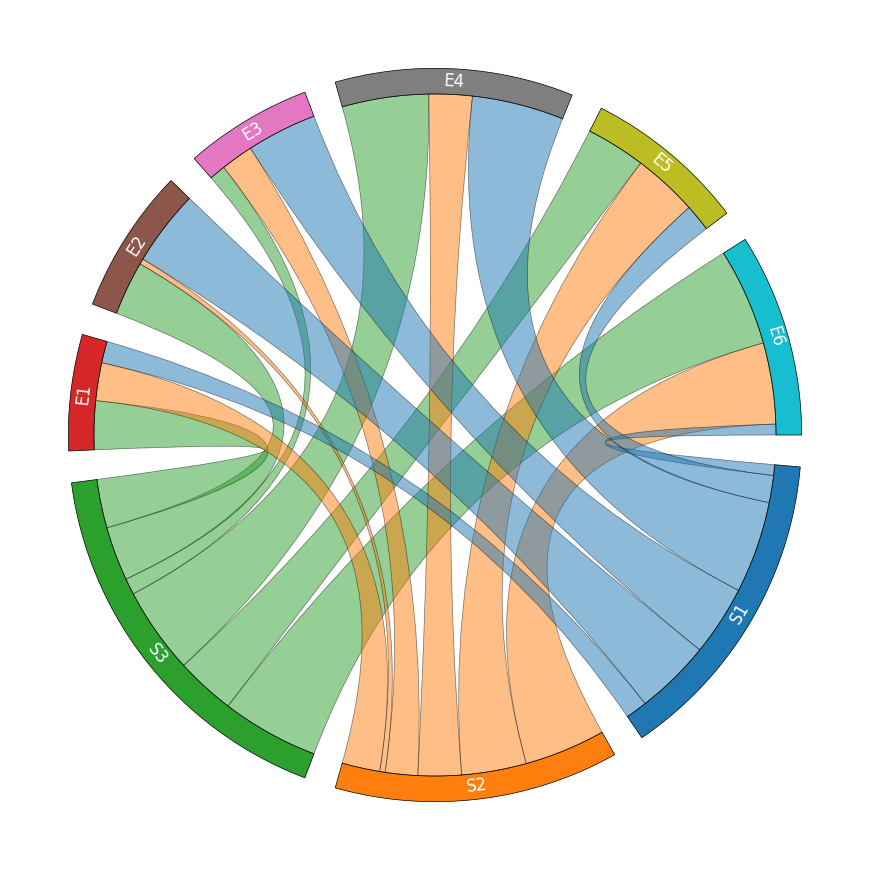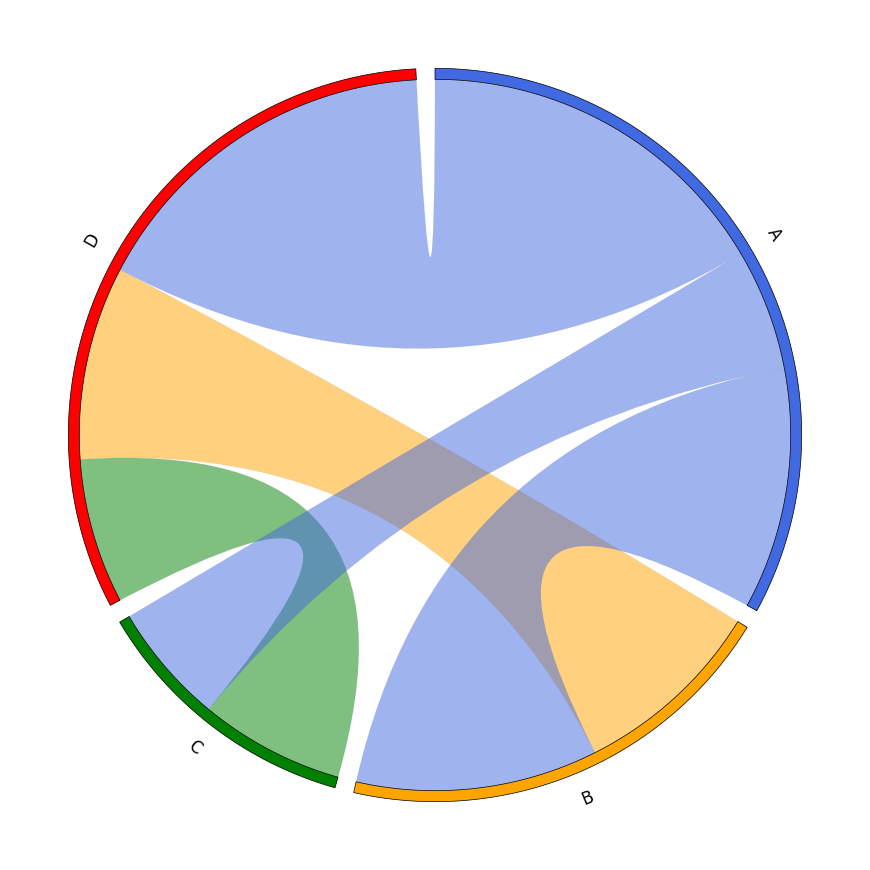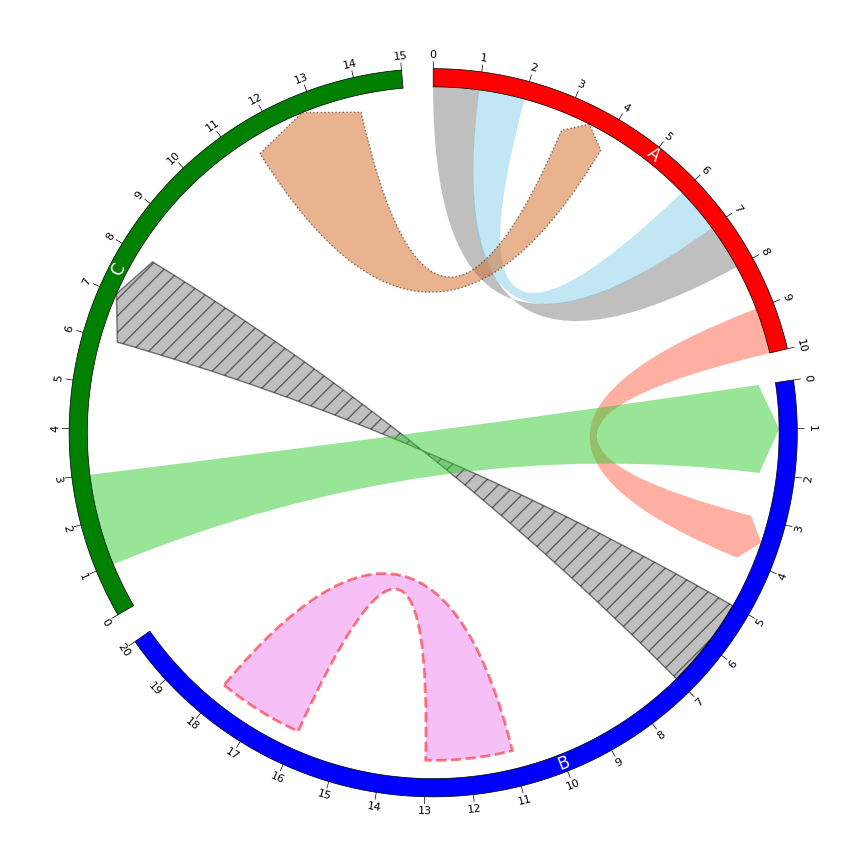はじめに
データ間のネットワークやフローのような相互関係を表現する際には円形でのデータ可視化がよく行われます。下記のような図はChord Diagramと呼ばれ、各データの相互関係を分かりやすく美しく可視化することができます。
本記事では、matplotlibをベースに個人開発したパッケージ pyCirclize (GitHub, Qiita紹介記事) を利用して、PythonでChord Diagramをプロットする方法を紹介します。
pyCirclizeのインストール
pyCirclizeはPyPIとconda-forgeにそれぞれパッケージを登録しているので、pipまたはcondaコマンドでインストール可能です。
PyPIパッケージ
pip install pycirclize
Condaパッケージ
conda install -c conda-forge pycirclize
Chord Diagramプロット方法
pyCirclizeを利用したChord Diagramのプロットコード例・図例を以降に記載しています。
1. 行列テーブルからプロット
プロット方法は簡単で、Circos.initialize_from_matrix()メソッドから行列データ読み込み及びChord Diagramプロット設定を行い、savefig()メソッドで図を出力するだけです。プロット設定は各要素間のスペース度数やカラーマップ、ラベル位置・サイズ、リンクの方向等の設定が可能です。
1-1. Example1 (3 x 6 行列)
from pycirclize import Circos
import pandas as pd
# Create matrix dataframe (3 x 6)
row_names = ["S1", "S2", "S3"]
col_names = ["E1", "E2", "E3", "E4", "E5", "E6"]
matrix_data = [
[4, 14, 13, 17, 5, 2],
[7, 1, 6, 8, 12, 15],
[9, 10, 3, 16, 11, 18],
]
matrix_df = pd.DataFrame(matrix_data, index=row_names, columns=col_names)
matrix_df.to_csv("matrix1.tsv", sep="\t")
# Initialize from matrix (Can also directly load tsv matrix file)
circos = Circos.initialize_from_matrix(
matrix_df,
start=-265,
end=95,
space=5,
r_lim=(93, 100),
cmap="tab10",
label_kws=dict(r=94, size=12, color="white"),
link_kws=dict(ec="black", lw=0.5),
)
circos.savefig("chord_diagram_matrix1.png")
E1 E2 E3 E4 E5 E6
S1 4 14 13 17 5 2
S2 7 1 6 8 12 15
S3 9 10 3 16 11 18
1-2. Example2 (10 x 10 行列)
from pycirclize import Circos
import pandas as pd
# Create matrix data (10 x 10)
row_names = list("ABCDEFGHIJ")
col_names = row_names
matrix_data = [
[51, 115, 60, 17, 120, 126, 115, 179, 127, 114],
[108, 138, 165, 170, 85, 221, 75, 107, 203, 79],
[108, 54, 72, 123, 84, 117, 106, 114, 50, 27],
[62, 134, 28, 185, 199, 179, 74, 94, 116, 108],
[211, 114, 49, 55, 202, 97, 10, 52, 99, 111],
[87, 6, 101, 117, 124, 171, 110, 14, 175, 164],
[167, 99, 109, 143, 98, 42, 95, 163, 134, 78],
[88, 83, 136, 71, 122, 20, 38, 264, 225, 115],
[145, 82, 87, 123, 121, 55, 80, 32, 50, 12],
[122, 109, 84, 94, 133, 75, 71, 115, 60, 210],
]
matrix_df = pd.DataFrame(matrix_data, index=row_names, columns=col_names)
matrix_df.to_csv("matrix2.tsv", sep="\t")
# Initialize from matrix (Can also directly load tsv matrix file)
circos = Circos.initialize_from_matrix(
matrix_df,
space=3,
r_lim=(93, 100),
cmap="tab10",
ticks_interval=500,
label_kws=dict(r=94, size=12, color="white"),
)
circos.savefig("chord_diagram_matrix2.png")
A B C D E F G H I J
A 51 115 60 17 120 126 115 179 127 114
B 108 138 165 170 85 221 75 107 203 79
C 108 54 72 123 84 117 106 114 50 27
D 62 134 28 185 199 179 74 94 116 108
E 211 114 49 55 202 97 10 52 99 111
F 87 6 101 117 124 171 110 14 175 164
G 167 99 109 143 98 42 95 163 134 78
H 88 83 136 71 122 20 38 264 225 115
I 145 82 87 123 121 55 80 32 50 12
J 122 109 84 94 133 75 71 115 60 210
1-3. Example3 (10 x 2 行列)
from pycirclize import Circos
import pandas as pd
# Create matrix data (10 x 2)
row_names = list("ABCDEFGHIJ")
col_names = list("KL")
matrix_data = [
[83, 79],
[90, 118],
[165, 81],
[121, 77],
[187, 197],
[177, 8],
[141, 127],
[29, 27],
[95, 82],
[107, 39],
]
matrix_df = pd.DataFrame(matrix_data, index=row_names, columns=col_names)
matrix_df.to_csv("matrix3.tsv", sep="\t")
# Initialize from matrix (Can also directly load tsv matrix file)
circos = Circos.initialize_from_matrix(
matrix_df,
space=2,
cmap="Set3",
label_kws=dict(size=12),
link_kws=dict(direction=1, ec="black", lw=0.5)
)
circos.savefig("chord_diagram_matrix3.png")
K L
A 83 79
B 90 118
C 165 81
D 121 77
E 187 197
F 177 8
G 141 127
H 29 27
I 95 82
J 107 39
2. 遷移テーブルからプロット
各要素間の移動・遷移量を示すようなデータテーブル(例: A -> B [値=10])をMatrix.parse_fromto_table()メソッドで行列テーブルに変換し、前節と同様にChord Diagramをプロットすることができます。
2-1. Example1
from pycirclize import Circos
from pycirclize.parser import Matrix
import pandas as pd
# Create from-to table dataframe & convert to matrix
fromto_table_df = pd.DataFrame(
[
["A", "B", 10],
["A", "C", 5],
["A", "D", 15],
["B", "D", 8],
["C", "D", 6],
],
columns=["from", "to", "value"], # Column name is optional
)
fromto_table_df.to_csv("fromto_table1.tsv", sep="\t", index=False)
matrix = Matrix.parse_fromto_table(fromto_table_df)
circos = Circos.initialize_from_matrix(
matrix,
space=3,
cmap=dict(A="royalblue", B="orange", C="green", D="red"),
label_kws=dict(size=12),
)
circos.savefig("chord_diagram_fromto_table1.png")
from to value
A B 10
A C 5
A D 15
B D 8
C D 6
2-2. Example2
from pycirclize import Circos
from pycirclize.parser import Matrix
import pandas as pd
# Create from-to table dataframe & convert to matrix
fromto_table_df = pd.DataFrame(
[
["A", "B", 10],
["A", "C", 5],
["A", "D", 15],
["A", "E", 20],
["A", "F", 3],
["B", "A", 3],
["B", "G", 15],
["F", "D", 13],
["F", "E", 2],
["E", "A", 20],
["E", "D", 6],
],
columns=["from", "to", "value"], # Column name is optional
)
fromto_table_df.to_csv("fromto_table2.tsv", sep="\t", index=False)
matrix = Matrix.parse_fromto_table(fromto_table_df)
circos = Circos.initialize_from_matrix(
matrix,
space=3,
cmap="viridis",
ticks_interval=5,
label_kws=dict(size=12, r=110),
link_kws=dict(direction=1, ec="black", lw=0.5),
)
circos.savefig("chord_diagram_fromto_table2.png")
from to value
A B 10
A C 5
A D 15
A E 20
A F 3
B A 3
B G 15
F D 13
F E 2
E A 20
E D 6
3. その他プロット
前項までの汎用的なChord Diagram以外にも、pyCirclizeの各種APIを活用することで以下のようなプロットを実行することもできます。詳細なプロットAPIに興味がある人は、Getting StartedやPlot API Exampleドキュメントを参照してみてください。
from pycirclize import Circos
sectors = {"A": 10, "B": 20, "C": 15}
name2color = {"A": "red", "B": "blue", "C": "green"}
circos = Circos(sectors, space=5)
for sector in circos.sectors:
track = sector.add_track((95, 100))
track.axis(fc=name2color[sector.name])
track.text(sector.name, color="white", size=12)
track.xticks_by_interval(1)
# Plot links in various styles
circos.link(("A", 0, 1), ("A", 7, 8))
circos.link(("A", 1, 2), ("A", 7, 6), color="skyblue")
circos.link(("A", 9, 10), ("B", 4, 3), direction=1, color="tomato")
circos.link(("B", 5, 7), ("C", 6, 8), direction=1, ec="black", lw=1, hatch="//")
circos.link(("B", 18, 16), ("B", 11, 13), r1=90, r2=90, color="violet", ec="red", lw=2, ls="dashed")
circos.link(("C", 1, 3), ("B", 2, 0), direction=1, color="limegreen")
circos.link(("C", 11.5, 14), ("A", 4, 3), direction=2, color="chocolate", ec="black", lw=1, ls="dotted")
circos.savefig("chord_diagram_other.png")
最後に
本記事では、pyCirclizeを利用したChord Diagramの基本的なプロット方法について紹介しました。pyCirclizeにはChord Diagram以外にも様々な円形プロットを可能とする機能を実装しているので、興味がある人がいればGitHubリポジトリを参照してみてください。
PythonではpyCirclizeの他にもd3blocksやholoviewsといったライブラリでもChord Diagramのプロットが可能ですが、プロットAPIのシンプルさやmatplotlibベースであるための拡張のしやすさ等ではpyCirclizeが少し優れているかなと思っています。ただ出力図へのインタラクティブな操作ができない点では明確に劣っているため、そういった機能が必要な人はd3blockやholoviewsを選択したほうがいいかもしれません。






